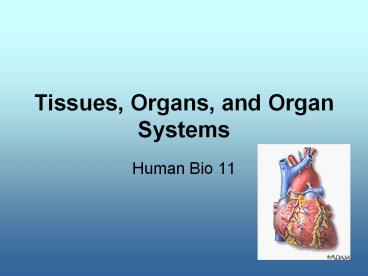Tissues, Organs, and Organ Systems - PowerPoint PPT Presentation
1 / 13
Title:
Tissues, Organs, and Organ Systems
Description:
Tissues, Organs, and Organ Systems Human Bio 11 Body Organization Organelle Cell Tissue Organ Organ System Organism Tissue A group of cells that work together to ... – PowerPoint PPT presentation
Number of Views:335
Avg rating:3.0/5.0
Title: Tissues, Organs, and Organ Systems
1
Tissues, Organs, and Organ Systems
- Human Bio 11
2
Body Organization
Organelle
Cell
Tissue
Organ
Organ System
Organism
3
Tissue
- A group of cells that work together to perform a
similar function. - Five main types
- Epithelial
- Connective
- Blood
- Muscle
- Nerve
4
Epithelial Tissue
- Covers entire body surface and most of the body's
inner cavities. - Outer epidermis (skin) protects from injury and
drying out. - Inner epidermal tissue protects and secretes
mucus (ex. along digestive tract).
5
Connective Tissue
- It binds structures together.
- Provides support and protection.
- Stores fat and other nutrients.
- Often made of collagen or elastin.
- Examples
- tendons, ligaments, cartilage, bone, blood
6
Connective Tissue
7
Muscle Tissue
- Contracts for movement.
- Composed of fibers made of actin and myosin
proteins.
8
Nerve Tissue
- Conduct electrochemical messages.
- Specialized tissue that forms nerves, brain,
spinal cord.
9
Organs
- A group of tissues joined in structure to serve a
common function. - Each located in specific location, with specific
functions.
10
Organ Systems
- Groups of organs that perform related functions.
- Organ systems contribute to maintaining a stable
internal environment. - Some organs can be part of more than one system.
- Example lungs ? respiratory and circulatory
11
1. Digestive convert food to usable nutrients
2. Circulatory transport of necessary molecules to cells
3. Immune defense against invading pathogens
4. Respiratory gas exchange
5. Excretory gets rid of metabolic wastes
6. Nervous Sensory regulation and control, response to stimuli, processing information
7. Muscular Skeletal support and movement
8. Endocrine regulation of internal environment, development
9. Reproductive producing offspring
12
(No Transcript)
13
Portfolio Work
- Body Organization Worksheets
- What is a Cell Worksheets
- What is a Tissue Worksheets
- What are Organs and Organ Systems Worksheets































